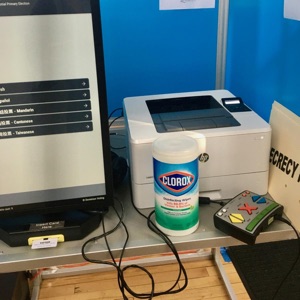Hi Folks,
Big changes are being planned for elections in California and beyond due to the coronavirus pandemic and uncertaintly about whether voting in person can be safely conducted. This issue of CVF-News provides a roundup of news and developments. For a more in-depth perspective, listen to my interview with John Howard and Tim Foster featured in this week's Capitol Weekly podcast.
Like many nonprofits, CVF relies on donations to support our work. On May 7th, CVF will join in the Sacramento region's Big Day of Giving fundraising event and I hope we can count on you to support our work in this important election year. Please visit our BDOG page and pledge a donation today!
-- Kim Alexander, President & Founder, California Voter Foundation
Over the past few weeks, broad consensus has developed among election officials, lawmakers and advocacy groups that for the November Presidential election, every registered California voter should receive their ballot in the mail.
The debate is over to what extent, if any, in-person voting options are also made available?
The perspectives range from in-person voting being authorized and encouraged but not required, which is the position the California Association of Clerks and Election Officials (CACEO) has taken, to sending everyone a ballot AND keeping all existing in-person voting options in place (advanced by labor groups and others) to something in between, allowing consolidation of polling places or the use of vote centers and expanding in-person early voting opportunities (advanced by numerous voter advocacy groups).
 |
| Vote center voting station in Sacramento County, February 29, 2020, featuring the Dominion ICX ballot-on-demand voting system and Clorox wipe |
CVF's recommendations were submitted to California Secretary of State Alex Padilla on March 27th and include several that have developed into additional points of consensus, such as providing a longer grace period for mail ballots postmarked by Election Day to be counted, expanding public awareness of remote accessible vote-by-mail which allows voters' ballots to be sent via email and returned as vote-by-mail ballots, and increasing the number of ballot drop-off locations, especially drive-up and 24-hour sites.
Another thing all stakeholders agree on is the need for election officials to have additional state budget resources to fund the cost of sending all registered voters ballots through the mail and to efficiently and securely process and count those ballots, including the personal protective equipment required for any in-person voting and to safely perform other election duties. Election officials and voter advocates alike also will need funding to conduct voter education and outreach campaigns and help voters unfamiliar with casting a vote-by-mail ballot do so successfully.
While there is consensus for the idea that every voter should receive a ballot in the mail, there is also recognition of significant challenges to making this happen. For the March 3 Primary, about 75 percent of the state's 20 million voters received a mail ballot.
Of the five million who did not, nearly half live in Los Angeles County, whose Board of Supervisors had already directed the county's registrar of voters, Dean Logan, to develop a plan for sending all of the county's 5.5 million voters a ballot for the November election in response to the widespread voting problems seen throughout the county on March 3.
LA's Board of Supervisors will meet on April 28th and take up a motion by Supervisors Janice Hahn and Sheila Kuehl to mail all voters a ballot. This meeting is being conducted remotely and a live webcast will be available. The meeting begins at 9:30 am and "General Election 2020 Vote by Mail" is agenda item #16 (though the board sometimes takes items out of order).
 |
| March 3, 2020 Primary election vote-by-mail ballot storage bins collected from Sacramento County vote centers await processing in the county's secure warehouse on March 4, 2020. |
Meanwhile, many people are paying close attention to other elections currently underway. The April 7 Wisconsin Primary provides a cautionary tale of what could happen if there is not consensus among leaders about how to enable safe voting during a pandemic. With few sites and limited staff available and vote-by-mail options restricted, voters in that state waited in lines for hours to vote, risking their health as well as that of election workers.
It was later reported that six voters and one election staffer in Milwaukee all tested positive for Covid-19. In New York City, two election board members have died from Covid-19 and more than a dozen sickened by the disease. Such news is traveling quickly among California's county election officials, some of whom have also fallen seriously ill from Covid-19 and all of whom, along with their staff, are struggling to continue performing critical election and governmental functions without risking their health.
Examples of what a pandemic voting model could look like can also be found in California, where local elections are taking place in several Southern California counties under an executive order signed by Governor Gavin Newsom on March 20 and a second one signed on April 9th allowing special municipal, recall and vacancy elections being held in April, May and June in Los Angeles, Riverside, Orange and Ventura counties to be conducted as all-mail ballot elections, with in-person voting options encouraged but not required.
Another looming concern is whether the US Postal Service will be adequately funded and staffed this Fall given the agency's financial troubles and staffing challenges, problems that are already impacting Ohio's all-mail ballot primary election currently underway.
CVF will continue paying close attention to these developments and watching for announcements of plans from the Secretary of State, Governor and legislative leaders in the coming weeks.

